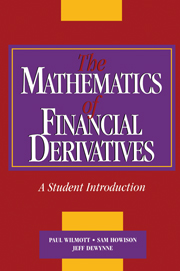Hints to Selected Exercises
Published online by Cambridge University Press: 05 June 2012
Summary
Chapter 1
1. Since the holder of one share just before a one-for-one split will hold two just after, and since the value and future prospects of the company are unaffected by what is only a nominal change, the stock price must be halved on the introduction of the new shares. The exercise prices of options are therefore also all halved, as are their values.
2. S – D; see Chapter 6.
3. Yes. One reason is that options provide insurance, and the larger the volatility the more the need for insurance against an unfavourable outcome from a position in the stock, and consequently the greater the expense. On the other side of the coin, when the volatility is high, the asset price is more likely to be high or low when the option expires. High prices make calls more valuable, low prices favour puts. We show these results in more detail later (see Chapter 5).
Chapter 2
1. Use equation (2.7).
3. Use the cumulative distribution function and the fact that for any s > 0, prob|S < s] = prob[log S < log s]; then differentiate to find the density function of S.
4. Use the general version of Itô's lemma given on page 27 to find a differential equation for f(G).
5. As with a function of a single variable, use Taylor's theorem with the additional ‘rules’ Chapter 3
Chapter 3
4. Remember that N(=∞) = 0 and N(∞) = 1.
- Type
- Chapter
- Information
- The Mathematics of Financial DerivativesA Student Introduction, pp. 295 - 307Publisher: Cambridge University PressPrint publication year: 1995



